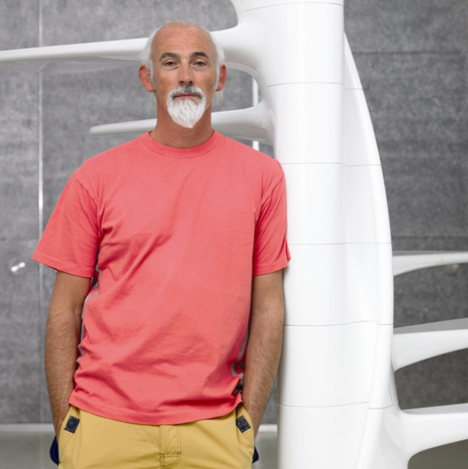
Design schools need to embrace digital says Ross Lovegrove
Milan 2015: the design industry is "way behind" architecture when it comes to technology, according to designer Ross Lovegrove, who says design schools should put a 3D printer on every desk.
Speaking to Dezeen in Milan this week, Lovegrove berated design schools for failing to teach students how to use digital tools and production methods.
"Design schools have got to really get into computational design," Lovegrove said. "There is no digital process in design schools."
"It's so analogue," he added. "It's way behind."
Lovegrove spoke to Dezeen at the launch of his 3D-printed shoes for United Nude in Milan. The exhibition also features designs by architects Zaha Hadid, Ben van Berkel and Fernando Romero, outnumbering Lovegrove and fellow product designer Michael Young in the project three to two.
"I think that's starting to say something, because it's a bit of a domain of architects and it's only because architects have a much more evolved process," Lovegrove said. "Compared to design, you see what's going on in architectural education establishments from the Bartlett to the AA to ETH in Zurich, it's incredible."
"The moment that 3D printers become cheaper, maybe they can be on the desktop in design schools," he added.

Lovegrove said that architectural institutions such as the AA and the Bartlett are pioneering the use of digital design techniques, but design schools have a long way to go to catch up.
"Those kind of schools that I go and teach at or I sit in on crits, I'm trying to find that exchange between the architectural research dialogue and try and bring that into product just to make that a bit more interesting," he said.
Last year Apple's head designer Jonathan Ive said that he struggled to hire young staff as schools were failing to teach them the correct skills. But rather than calling for more technology, Ive said schools were relying too heavily on "cheap" computers and were not teaching students how to make physical products.
London-based Lovegrove has been advocating digital design for 17 years, since he got rid of his workshop and starting designing entirely using digital software. However, he has to employ architects to work for him in this way because designers aren't taught the necessary skills.
"It's such hard work, because you have to employ really advanced people, they cost a fortune," Lovegrove said. "All my people come out of architectural schools. I can't employ designers because they can't do this, and I don't want to go backwards just to earn that living, it's better that I fail."
He also said that the design industry needs to embrace digital production techniques in order to be able to create the complex forms made using advanced software.
The designer's recent projects include sculptural lights and a pavilion made from stretch-foil for Barrisol, as well as an aluminium stacking chair for Italian furniture brand Moroso with a computer-generated design that utilises metal-pressing techniques from the car industry. Last year he created his first wooden chair – a walnut seat with a continuous curving structure.
"It's very difficult to earn a living when the standard way of producing things in industry is incredibly mechanical and piece part, it's not very 3D," he said. "If you want to make form in industry, it actually costs quite a lot of money unless you injection-mould, and use these existing techniques of industrialisation."
"My biggest problem right now is finding clients because we have to do everything for the client," he said. "I do all of the production data, and I'm paid zero, but how can I run a studio? I mean, you can't."
Lovegrove's shoes will be on display at the United Nude exhibition at Milan's Teatro Arsenale until 19 April.